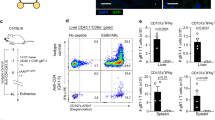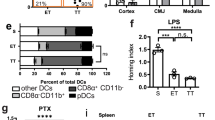Abstract
Myeloid antigen-presenting cells (APC) are known to cross-present exogenous antigen on major histocompatibility class I molecules to CD8+ T cells and thereby induce protective immunity against infecting microorganisms. Here we report that liver sinusoidal endothelial cells (LSEC) are organ-resident, non-myeloid APC capable of cross-presenting soluble exogenous antigen to CD8+ T cells. Though LSEC employ similar molecular mechanisms for cross-presentation as dendritic cells, the outcome of cross-presentation by LSEC is CD8+ T cell tolerance rather than immunity. As uptake of circulating antigens into LSEC occurs efficiently in vivo, it is likely that cross-presentation by LSEC contributes to CD8+ T cell tolerance observed in situations where soluble antigen is present in the circulation.
This is a preview of subscription content, access via your institution
Access options
Subscribe to this journal
Receive 12 print issues and online access
$209.00 per year
only $17.42 per issue
Buy this article
- Purchase on Springer Link
- Instant access to full article PDF
Prices may be subject to local taxes which are calculated during checkout





Similar content being viewed by others
References
Zinkernagel, R. et al. Antigen localisation regulates immune responses in a dose- and time-dependent fashion: a geographical view of immune reactivity. Immunol. Rev. 156, 199–209 (1997).
Sigal, L.J., Crotty, S., Andino, R. & Rock, K.L. Cytotoxic T-cell immunity to virus-infected non-haematopoietic cells requires presentation of exogenous antigen. Nature 398, 77–80 (1999).
Bevan, M.J. Cross-priming for a secondary cytotoxic response to minor H antigens with H-2 congenic cells which do not cross-react in the cytotoxic assay. J. Exp. Med. 143, 1283–1288 (1976).
Rodriguez, A., Regnault, A., Kleijmeer, M., Ricciardi-Castagnoli, P. & Amigorena, S. Selective transport of internalized antigens to the cytosol for MHC-class I presentation in dendritic cells. Nature Cell Biol. 1, 362–368 (1999).
Heath, W.R., Kurts, C., Miller, J.F. & Carbone, F.R. Cross-tolerance: a pathway for inducing tolerance to peripheral tissue antigens. J. Exp. Med. 187, 1549–1553 (1998).
Starzl, T.E. & Zinkernagel, R.M. Antigen localization and migration in immunity and tolerance. N. Engl. J. Med. 339, 1905–1913 (1998).
Liblau, R.S. et al. Intravenous injection of soluble antigen induces thymic and peripheral T-cells apoptosis. Proc. Natl. Acad. Sci. USA 93, 3031–3036 (1996).
Gütgemann, I., Fahrer, A.M., Altman, J.D., Davis, M.M. & Chien, Y.H. Induction of rapid T cell activation and tolerance by systemic presentation of an orally administered antigen. Immunity 8, 667–673 (1998).
Calne, R.Y. Induction of immunological tolerance by porcine liver allografts. Nature 223, 472–476 (1969).
Cantor, H. & Dumont, A. Hepatic suppression of sensitization to antigen absorbed into the portal system. Nature 215, 744 (1967).
MacPhee, P.J., Schmidt, E.E. & Groom, A.C. Intermittence of blood flow in liver sinusoids, studied by high-resolution in vivo microscopy. Am. J. Physiol. [AUTHOR: Do you have an issue number?] G692–698 (1995).
Wong, J. et al. A minimal role for selectins in the recruitment of leukocytes into the inflamed liver microvasculature. J. Clin. Invest. 99, 2782–2790 (1997).
Knolle, P. & Gerken, G. Local regulation of the immune response in the liver. Immunol. Rev. 174, 21–34 (2000).
Rubinstein, D., Roska, A.K. & Lipsky, P.E. Liver sinusoidal lining cells express class II major histocompatibility antigens but are poor stimulators of fresh allogeneic T lymphocytes. J. Immunol. 137, 1803–1810 (1986).
Callery, M.P., Kamei, T. & Flye, M.W. Kupffer cell blockade inhibits induction of tolerance by the portal venous route. Transplantation 47, 1092–1094 (1989).
Gorczynski, L. et al. Evidence that an OX-2-positive cell can inhibit the stimulation of type 1 cytokine production by bone marrow-derived B7–1 (and B7-2)-positive dendritic cells. J. Immunol. 162, 774–781 (1999).
Thomson, A.W. & Lu, L. Are dendritic cells the key to liver transplant tolerance? Immunol. Today 20, 27–32 (1999).
Smedsrod, B., Pertoft, H., Gustafson, S. & Laurent, T.C. Scavenger functions of the liver endothelial cell. Biochem. J. 266, 313–327 (1990).
Knolle, P. et al. Liver sinusoidal endothelial cells can prime naive CD4+ T cells in the absence of IL-12 and induce IL-4 production in primed CD4+ T cells: Implications for tolerance induction in the liver. Gastroenterology 116, 1428–1440 (1999).
Hämmerling, G.J., Schönrich, G., Ferber, I. & Arnold, B. Peripheral tolerance as a multi-step mechanism. Immunol. Rev. 133, 93–104 (1993).
Ashwell, G. & Steer, C.J. Hepatic recognition and catabolism of serum glycoproteins. JAMA 246, 2358–2364 (1981).
Kindberg, G.M., Magnusson, S., Berg, T. & Smedsrod, B. Receptor-mediated endocytosis of ovalbumin by two carbohydrate-specific receptors in rat liver cells. The intracellular transport of ovalbumin to lysosomes is faster in liver endothelial cells than in parenchymal cells. Biochem. J. 270, 197–203 (1990).
Lanzavecchia, A. Mechanisms of antigen uptake for presentation. Curr. Opin. Immunol. 8, 348–354 (1996).
Kovacsovics-Bankowski, M., Clark, K., Benacerraf, B. & Rock, K.L. Efficient major histocompatibility complex class I presentation of exogenous antigen upon phagocytosis by macrophages. Proc. Natl. Acad. Sci. USA 90, 4942–4946 (1993).
Paglia, P., Chiodoni, C., Rodolfo, M. & Colombo, M.P. Murine dendritic cells loaded in vitro with soluble protein prime cytotoxic T lymphocytes against tumor antigen in vivo. J. Exp. Med. 183, 317–322 (1996).
Harding, C.V. & Song, R. Phagocytic processing of exogenous particulate antigens by macrophages for presentation by class I MHC-molecules. J. Immunol. 153, 4925–4933 (1994).
Ke, Y. & Kapp, J.A. Exogenous antigens gain access to the major histocompatibility complex class I processing pathway in B cells by receptor-mediated uptake. J. Exp. Med. 184, 1179–1184 (1996).
Mitchell, D.A., Nair, S.K. & Gilboa, E. Dendritic cell/macrophage precursors capture exogenous antigen for MHC-class I presentation by dendritic cells. Eur. J. Immunol. 28, 1923–1933 (1998).
O'Connell, P.J., Morelli, A.E., Logar, A.J. & Thomson, A.W. Phenotypic and functional characterization of mouse hepatic CD8 alpha+ lymphoid-related dendritic cells. J. Immunol. 165, 795–803 (2000).
Morelli, A.E. et al. Preferential induction of Th1 responses by functionally mature hepatic (CD8alpha− and CD8alpha+) dendritic cells: association with conversion from liver transplant tolerance to acute rejection. Transplantation 69, 2647–2657 (2000).
Sprent, J. Presidential address to the American Association of Immunologists. Stimulating naive T cells. J. Immunol. 163, 4629–4636 (1999).
Scoazec, J.Y. & Feldmann, G. The cell adhesion molecules of hepatic sinusoidal endothelial cells. J. Hepatol. 20, 296–300 (1994).
Kurts, C. et al. CD8 T cell ignorance or tolerance to islet antigens depends on antigen dose. Proc. Natl. Acad. Sci. USA 96, 12703–12707 (1999).
Vabulas, R.M., Pircher, H., Lipford, G.B., Hacker, H. & Wagner, H. CpG–DNA activates in vivo T cell epitope presenting dendritic cells to trigger protective antiviral cytotoxic T cell responses. J. Immunol. 164, 2372–2378 (2000).
Bercovici, N. et al. Chronic intravenous injections of antigen induce and maintain tolerance in T cell receptor-transgenic mice. Eur. J. Immunol. 29, 345–354 (1999).
Falb, D. et al. Peripheral tolerance in T cell receptor-transgenic mice: evidence for T cell anergy. Eur. J. Immunol. 26, 130–135 (1996).
Sun, J., Dirden-Kramer, B., Ito, K., Ernst, P.B. & Van Houten, N. Antigen-specific T cell activation and proliferation during oral tolerance induction. J. Immunol. 162, 5868–5875 (1999).
Wu, J.Y. et al. Accessory cell requirements for saponin adjuvant-induced class I MHC antigen-restricted cytotoxic T-lymphocytes. Cell. Immunol. 154, 393–406 (1994).
Belz, G., Altman, J. & Doherty, P. Characteristics of virus-specific CD8+ T cells in the liver during the control and resolution phases of influenza pneumonia. Proc. Natl. Acad. Sci. USA 95, 13812–13817 (1998).
Huang, L., Soldevila, G., Leeker, M., Flavell, R. & Crispe, I.N. The liver eliminates T cells undergoing antigen-triggered apoptosis in vivo. Immunity 1, 741–749 (1994).
Kamada, N. & Wight, D.G. Antigen-specific immunosuppression induced by liver transplantation in the rat. Transplantation 38, 217–221 (1984).
Chisari, F.V. & Ferrari, C. Hepatitis B virus immunopathogenesis. Annu. Rev. Immunol. 13, 29–60 (1995).
Ljunggren, H.G., Glas, R., Sandberg, J.K. & Karre, K. Reactivity and specificity of CD8+ T cells in mice with defects in the MHC-class I antigen-presenting pathway. Immunol. Rev. 151, 123–148 (1996).
Schwarz, K. et al. The use of LCMV-specific T cell hybridomas for the quantitative analysis of MHC-class I restricted antigen presentation [letter]. J. Immunol. Methods 237, 199–202 (2000).
Woo, J. et al. Isolation, phenotype, and allostimulatory activity of mouse liver dendritic cells. Transplantation 58, 484–491 (1994).
Acknowledgements
The authors thank S. Hegenbarth and A. Klevenz for technical assistance; N. Shastri for providing the ovalbumin-specific T-cell hybridoma B3Z, H. Rammensee for providing β-gal–specific T-cell clone 0805B; and L. Eisenbach and A. Porgador for supplying us with Kb-SIINFEKL-specific antibody 25-D1.16. This work was supported by a grant from the Deutsche Forschungsgemeinschaft to P.A.K. (Kn 437/1-5 and SFB 405 project A7) and a European Union grant to B.A. (BIO-97-2151).
Author information
Authors and Affiliations
Corresponding author
Rights and permissions
About this article
Cite this article
Limmer, A., Ohl, J., Kurts, C. et al. Efficient presentation of exogenous antigen by liver endothelial cells to CD8+ T cells results in antigen-specific T-cell tolerance. Nat Med 6, 1348–1354 (2000). https://doi.org/10.1038/82161
Received:
Accepted:
Issue Date:
DOI: https://doi.org/10.1038/82161
This article is cited by
-
Progress of immune checkpoint inhibitors therapy for non-small cell lung cancer with liver metastases
British Journal of Cancer (2024)
-
Remodeling the hepatic fibrotic microenvironment with emerging nanotherapeutics: a comprehensive review
Journal of Nanobiotechnology (2023)
-
Splenectomy induces biochemical remission and regeneration in experimental murine autoimmune hepatitis
European Journal of Medical Research (2022)
-
Immunomodulation by endothelial cells — partnering up with the immune system?
Nature Reviews Immunology (2022)
-
Harnessing the liver to induce antigen-specific immune tolerance
Seminars in Immunopathology (2022)



